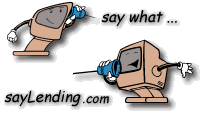 |
|||||||||||||||||||||||||||||||||||||||||
Zero Down Mortgages:Advantages and Disadvantages |
|||||||||||||||||||||||||||||||||||||||||
Zero Down Mortgages:Sponsored Programs |
|||||||||||||||||||||||||||||||||||||||||
Fannie Mae's Community Program: Mortgage loan programs targeted for home buyers at low and moderate income levels
To qualify for this loan, the homebuyer must earn no more than the area median income
Fannie Mae Low-Down Mortgages:
Freddie
Mac Low Down Mortgages:
|
|||||||||||||||||||||||||||||||||||||||||
Zero Down Mortgages:100%+ Program |
|||||||||||||||||||||||||||||||||||||||||
The 100%+ home buyer programs allow applicants to buy their first home without bringing any money to the table.
Let's use this table to illustrate:
Other options to consider:
|
|||||||||||||||||||||||||||||||||||||||||
Zero Down Mortgages:Using Investments for Your Down Payment |
|||||||||||||||||||||||||||||||||||||||||
New IRS rules and lending products have been developed that assist first-time home buyers into their first home.
Using Your IRA Investments: IRS rules allow for an one-time distribution from qualified IRA accounts
Using Your Personal Investments: This type of of Pledged-Asset Mortgage product may not be suitable for first-time buyers.
Generally, pledged assets are maintained in a collateral account maintained by the lender.
Homeowners should calculate the investment difference
Using Family or Other Investment: Many families want to help young people get started on home ownership with a gift that usually goes towards the down payment.
Relatives can help with your down payment by "gifting" to you some of the money.
|
|||||||||||||||||||||||||||||||||||||||||
Zero Down Mortgages:Working with PMI |
|||||||||||||||||||||||||||||||||||||||||
The standard down payment percentage is 20% of the home's purchase price.
PMI is mortgage default insurance that is required for all conventional mortgage loans with less than a 20% down payment.
Costs can vary depending on the mortgage loan amount, size of the down payment, and type of mortgage loan.
|
|||||||||||||||||||||||||||||||||||||||||
Zero Down Mortgages:What Are Piggy-Back Loans |
|||||||||||||||||||||||||||||||||||||||||
Many lenders now offer the piggyback loan for home buyers who want to avoid PMI payments.
The most common piggyback
loan is the 80/10/10:
The interest rate on the second mortgage loan is generally higher than the first mortgage.
|
|||||||||||||||||||||||||||||||||||||||||
|
|||||||||||||||||||||||||||||||||||||||||
 |